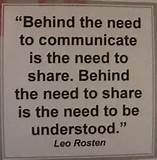Avoid Cross Cultural Communication Breakdowns: Understand Language Differences
 When it comes to understanding someone who is from another culture who has a strong foreign accent, how do we listen more effectively to assure that the exchange is successful? Both the listener and the speaker are responsible for making sure that each party has understood. Both the listener and the speaker can use strategies to improve the situation. Here is a tip for the listener who is listening to the hard-to-understand person:
When it comes to understanding someone who is from another culture who has a strong foreign accent, how do we listen more effectively to assure that the exchange is successful? Both the listener and the speaker are responsible for making sure that each party has understood. Both the listener and the speaker can use strategies to improve the situation. Here is a tip for the listener who is listening to the hard-to-understand person:
Be educated about the differences between languages. Certain languages have characteristics that are unique to that language. Since a language learner adapts what he knows about his language onto the new language, real differences in the way words are spoken occur. This fact can make the second language learner difficult to understand and can be a distraction to our ears.
There are many languages that don’t sound at all as rhythmic and melodious as English.
For example, many Indian languages emphasize syllable stress differently than we do. Their speech is flatter in pitch and syllables are the same length. Hearing some Indian speakers will sound very staccato to our ears. Their words will not sound the same as English. For example words like develop and contribute will sound like de-ve-lop and con-tri-bute. Many words with multiple syllables will sound this way. Because this is so different from American English, we as the listener are distracted by these words. Here are some other differences
Arabic has predictable word stress in sentences which is unlike English which is less predictable.
Some Asian languages sound sing-songy because their language is more tonal where they have one word that has multiple meanings based on which pitch it is spoken. Again, this may be a distraction when transferred to English.
Many languages don’t have the /th/ sound. This is an important sound in English and although it may not make the speaker difficult to understand in itself, it could be a distraction. And whenever there is a distraction, we tend to pay attention to it and try to process it.
Many countries have gestures and nonverbal expressions that are completely different from gestural expressions in America. What we know as normal and acceptable may have a completely opposite meaning in other countries. For instance, handshaking differs from country to country in terms of their interpretation and how they are done.
To learn more, there are many resources available that give in-depth descriptions of differences. There are books, webinars and classes or you can ask your employer to hire a specialist to do training on cross cultural communication. Let me know if I can help.
Being aware of the differences you might expect to hear from a non-native speaker goes a long way towards improving understanding and building relationships with that speaker.
